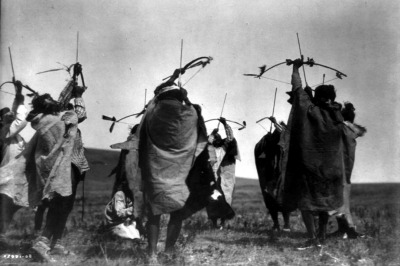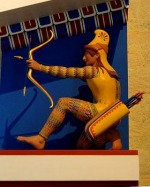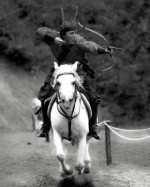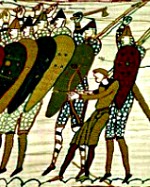The Making of the Native American Bow and Arrow
Talk the Talk
A self-bow is a weapon made from a single piece of wood while the more advanced
composite-bow incorporates several materials such as wood, horn or whatever was available to the craftsman making it.
Walk the Walk
Once his bow and arrows were made, a
Native American warrior would decorate them with his own personal design of complex geometrical patterns
so that his kills could be identified on the battlefield or at the end of a hunt.
Archery Quote
"The first gift I received from my father was a bow and arrows. He made them himself. He painted the bow red, which signified that he had been wounded in
battle.
I was very young at the time, so the arrows were fashioned with knobs on the end, instead of the sharp points.
I was very young at the time, so the arrows were fashioned with knobs on the end, instead of the sharp points.
The bow was not a strong one to pull.
That bow and arrows was the beginning of my Indian training.
It was to be my weapon in war and was to get my food for me. I always kept it near me".
~ Standing Bear ~
~ Standing Bear ~
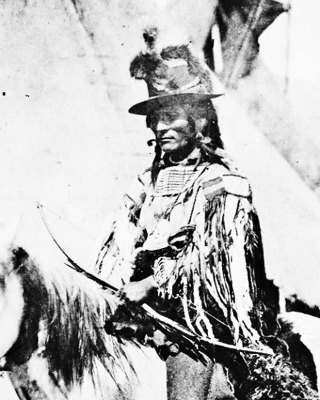 Although archery is synonymous with the history of Native American warriors, it began on the continent relatively late and was not invented there until around 500 CE. One of the earliest areas to use it was Iowa, a region that had already been populated for around eleven thousand, five hundred years by the time Native American archery first began.
Although archery is synonymous with the history of Native American warriors, it began on the continent relatively late and was not invented there until around 500 CE. One of the earliest areas to use it was Iowa, a region that had already been populated for around eleven thousand, five hundred years by the time Native American archery first began. Archery soon replaced the spear as the primary hunting tool and weapon of war as it provided the warrior with several advantages. It had far more rapid-fire capabilities, better accuracy, it allowed a for greater mobility and as spearheads were much larger, they also needed more raw materials to make compared to arrowheads.
Making the Native American Bow
The materials used to make a Native American bow would vary depending on what resources were available and what type of bow it would be. Weapons that were made earlier in archery history prior to the introduction of the horse to a given region, were intended for use on foot. They would be up to five feet tall and usually just made of wood, commonly known as a self-bow.If it was intended to be used while mounted on horseback, it would be shorter to make it more manoeuvrable and made of a mixture of materials (known as a composite bow) such as wood, horn or antler. Making a Native American bow was a complex job that took time and a considerable amount of skill. The wood would be stretched for a week or more by the craftsman who would then cut notches at either end for the string. Next, it would be coated in protective liquids and allowed to dry out over a fire before the imperfections on the bow were smoothed out and the other components such as the bow string attached.
Adding the String to the Bow
The strings could be made from various materials, depending on what was available to the craftsman at the time. They were often made from sinew taken from a back or leg tendon of an animal (often a buffalo), from rawhide, cord from the neck of a turtle or from the gut of an animal. The string could also be made from plant fibres such as nettles, milkweed, dogbane or the inner bark of trees such as basswood.Strings made from plant fibres involved much more work so were less common but as they were more stretch resistant and more durable in damp conditions, they tended to be of a higher quality. Leather wrist guards were worn to protect the Native American warrior from the impact of the bowstring though in some cases they could be made of carved bone, ivory, antler or, as with the Navajo Tribe, they could even be ornate silver bracers.
How Native Americans Made Their Arrows
The arrows could be made from a variety of shoots or reeds that were heated, straightened and weighted with a wooden shaft in a process that was very similar to that used for making the bow. The head of the arrow could be made from stone or antler that would be ground down, beat into small pieces and then sharpened (though after the arrival of the Europeans, they would be replaced by metal arrowheads).A hole would be bored into the bottom of the arrowhead so it could be attached to the arrow then it would be secured with buffalo hide. A feather fletching was used to give the arrow balance and to improve its trajectory; turkey feathers were a favoured choice but they could also come from crows, eagles, hawks or geese.
The process involved in making arrows for a Native American warrior was very time-consuming, even more so than making the bows as the fighting men of a tribe would need many arrows. This was especially true in times of ongoing intertribal warfare and during the period of European encroachment.
Native American Products. [Internet]. 2009. The University of Chicago. Available from: http://people.ucls.uchicago.edu/~snekros/2008-9%20webquests/products3/index.html [Accessed January 17, 2014].
Weitzel, T. [Internet]. 2013. American Indian Archery Technology. The University of Iowa. Available from: http://www.uiowa.edu/~osa/learn/ancient/archery.htm [Accessed January 17, 2014].
The process involved in making arrows for a Native American warrior was very time-consuming, even more so than making the bows as the fighting men of a tribe would need many arrows. This was especially true in times of ongoing intertribal warfare and during the period of European encroachment.
When the firearm was brought to America, it was a turning point in archery history as like in other parts of the world, the use of the bow and arrow as the primary weapon of war began to wane. However, it was not until the invention of the rifle that the gun gave a Native American warrior better range and accuracy though it was never fully replaced as the bow and arrow was much quieter, which was advantageous during stealth attacks. Today the tradition of making Native American bow and arrows lives on though they are no longer used as weapons of war. Instead, they are made for ceremonial purposes, sold as craftworks or used for the sport and enjoyment of Native American archers.
Written by Andrew Griffiths – Last updated 25/07/2023. If you like
what you see, consider following the History of Fighting on social media.
Further Reading:
Archery Equipment of the Americas. [Internet]. 2013. The Museum of Anthropology. Available from: http://anthromuseum.missouri.edu/grayson/americasarchery/americasarchery.shtml [Accessed January 17, 2014].Native American Products. [Internet]. 2009. The University of Chicago. Available from: http://people.ucls.uchicago.edu/~snekros/2008-9%20webquests/products3/index.html [Accessed January 17, 2014].
Weitzel, T. [Internet]. 2013. American Indian Archery Technology. The University of Iowa. Available from: http://www.uiowa.edu/~osa/learn/ancient/archery.htm [Accessed January 17, 2014].
More Archery History
Archery History Home
The bow and arrow has been used since at least the Palaeolithic Era (late Stone Age) and the earliest known composite bow was used in Egypt c.2800 BCE. Ancient and medieval archery were used for hunting and warfare though with the invention of the firearm, modern archery has developed into a popular sport that is enjoyed all over the world.
The bow and arrow has been used since at least the Palaeolithic Era (late Stone Age) and the earliest known composite bow was used in Egypt c.2800 BCE. Ancient and medieval archery were used for hunting and warfare though with the invention of the firearm, modern archery has developed into a popular sport that is enjoyed all over the world.
Mongolian Archery
The history of Mongolian archery dates back for thousands of years and has been used for hunting, sport and warfare. The Mongolian bow was one of the most powerful hand-held weapons in the world up to the modern era and helped Genghis Khan and his descendants build one of the largest empires the world has ever seen.
The history of Mongolian archery dates back for thousands of years and has been used for hunting, sport and warfare. The Mongolian bow was one of the most powerful hand-held weapons in the world up to the modern era and helped Genghis Khan and his descendants build one of the largest empires the world has ever seen.
The History of Archery in Korea
The history of archery in Korea stretches back to pre-history and the bow and arrow has been used there since at least the fifth century BCE. Traditional Korean archers helped to unify the country, gain independence from China and later to fend off Japanese invaders. In modern times, South Korea are
continuously making Olympic archery history and are widely considered to be the best in the world.
Archery History in Medieval England
Archery history in England saw the use of various forms of bow and arrow, including the short bow, crossbow and the medieval longbow. While the medieval short bow’s usefulness on the battlefield was limited, the crossbow and later the longbow helped English forces defeat much larger opponents which ultimately led to medieval archers gaining respect and prestige.
Archery history in England saw the use of various forms of bow and arrow, including the short bow, crossbow and the medieval longbow. While the medieval short bow’s usefulness on the battlefield was limited, the crossbow and later the longbow helped English forces defeat much larger opponents which ultimately led to medieval archers gaining respect and prestige.
The images on this site are believed to be in the public domain, however, if any mistakes have been made and your copyright or intellectual rights have been breeched, please contact andrew@articlesonhistory.com.

